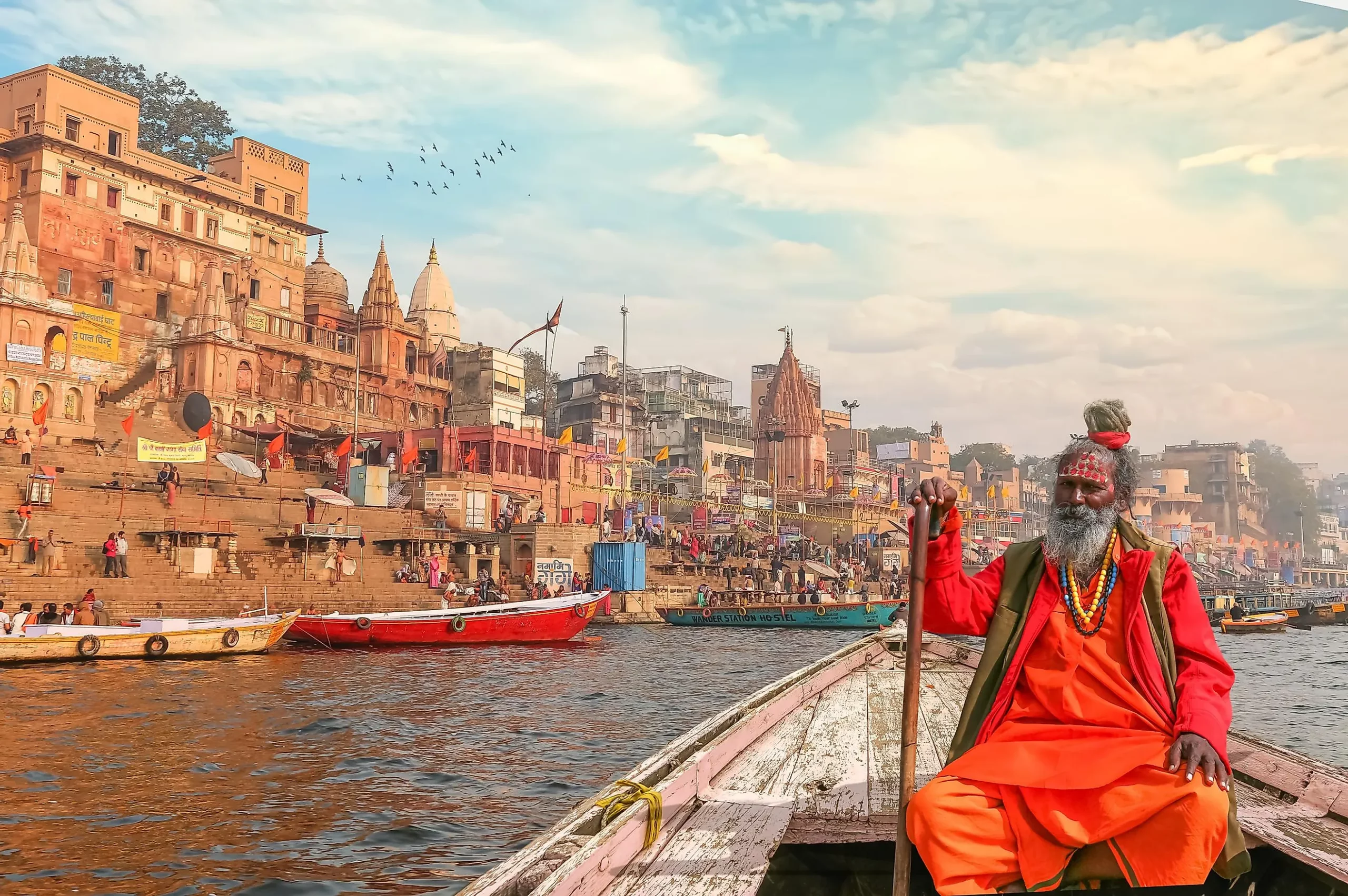
Varanasi is situated at the highest point between the Ganges and the Varuna, with an average altitude of about 80m. Due to the absence of tributaries and canals, the terrain is quite dry, which in the past must have been suitable for settlement. However, the present location of the town is somewhat different from that indicated in some ancient texts.
The distance between the confluence of the Ganges and the Varuna on one side and the Ganges and the Assi on the other, where Varanasi is located, is 4 km. Hindus usually make a pilgrimage called Pancha-Kroshi Yatra to these two places, which ends at the Sakshi Vinayaka temple.
The Ganges valley attracts crowds of pilgrims. Jains, Buddhists and Hindus from all over the world seek access to the holy city of Varanasi in the north-eastern Indian state of Uttar Pradesh. It is here that Brahminical teachings are concentrated. Varanasi is considered one of the oldest cities in the world.
Pilgrims wash their sins in the waters of the Ganges and cremate their relatives on the banks of the river. It is the place where the spiritual and physical worlds intertwine. Varanasi is home to many ancient temples. The locals are engaged in the production of fine silk to make saris, dresses and other products.
History of the city in the late 19th century
Varanasi lies for about 8 km at 25.283333, 83.066667 (from Greenwich), extending in amphitheatre along the left bank of the Ganges, which at this point forms a small bay and has a width varying with the seasons from 550 to 850 m at a depth of 25 to 30 m. B., seen from the bank of the Ganges, presents a very original and picturesque view. It consists of a maze of dark, damp, muddy, winding, narrow streets through which an elephant cannot pass everywhere. Carriages are not in use here. The houses, numbering 3,571 in 1872, are mostly three-storey, but five- and six-storey houses are also common. As each upper storey is slightly forward of the one below, the upper floors of the houses facing each other are almost flush. Many of them have balconies, balustrades and round or rather pyramidal domes. The variety of colours in which most of them are painted and the depiction of flowers, animals, men and gods on the front give them a very original appearance. Varanasi is the centre of the cult of Shiva, or Manadeva, and there are more than 1000 temples dedicated to this deity in the city. But most of them are not architecturally grandiose; the oldest, the most important and the most revered and visited among them is the temple of Vishrayesa, i.e. the Lord of Peace. In all these temples, the main object of veneration is the standing stone lingam. Bulls consecrated to Shiva run freely all over the streets of the city, while in many Durga temples one finds jumping monkeys, which are bred and groomed there, almost at every corner. Of the temples of the Jaina sect, the Man Mandil House or Mandil Singa, which in 1680 was converted into an observatory and furnished with wonderful astronomical instruments, is still preserved, and the Mandil Jain or Jaina Temple, though now in ruins, are all remarkable in their architecture. Among the three hundred mosques of B., one of the most magnificent is that of Aureng-Zeba, built near the bank of the Ganges, on the site of a ruined Hindu temple, with three domes and two minarets.
The population of Benares amounts to 207570 (1881), but varies enormously owing to the multitude of devotees and other strangers who descend daily on Benares, whose number during the Ram Leela and Davalli, the two greatest and brightest of all the religious festivals of Benares, reaches over 100,000. Among them are more than 20,000 Brahmins, many beggars, vagabonds, vagabonds of all kinds and perpetually covered with mud, almost completely naked fakirs. But in addition, many rich and noble Hindus settle in Varanasi temporarily or in the last years of their lives, where some die. The stone steps (ghats) leading from the promenade to the Ganges are the favourite places for the locals to walk. To die near the Ganges, the sick who lie dying are ordered to climb these stairs, where the corpses are burnt. It is believed that if a person dies here, his soul will no longer be reincarnated, it will come out of the wheel of Sansara. B. remains now, as in the old days, the centre of Brahmanical scholarship and science, though in modern times it has increasingly come into competition with Benares Calcutta, especially in the study of languages. The Pandits of Benares are still considered the foremost authorities on all religious matters. Of the numerous educational institutions, the Hindu College and the Sanskrit College, established in 1792, are notable; both are subsidised by the English government. The first teaches reading, writing and arithmetic, Hindu law, sacred Hindu literature in Sanskrit and astronomy. In the other, English language, English history and literature, Sanskrit language, Hindu and Persian languages, as well as mathematics, political economy, etc. are taught. B. is also the seat of a flourishing industry and is of great commercial importance. Jewellery of precious metals, gold and silver fabrics, velvet, silk and paper materials are famous in trade. Everything that India and its neighbouring countries produce in the field of art and workmanship, as well as all natural products, together with all kinds of works of English industry, are brought here for sale. Of the merchants of Benares, some belong to the richest in all India. – B. is a very ancient city, which in the Sanskrit poems is called Kazi, i.e., brilliant, and is considered to be the oldest school of the Brahmans. In 1193 it was conquered by the Guri Qutb-ed-din and in 1529 it was annexed by Baber to the Delhi Empire. On the fall of the latter in the early 17th century, the Prince of Gazipur became lord of the city and of the B. country, and in 1775 it came under the rule of the Anglo-Ost India Company, which succeeded him in 1781 and annexed the city and its district to its dominions. Cf. Sherring, “The sacred city of the Hindus; an account of B. in ancient and modern times” (London, 1868); his, “Hindu tribes and castes, as represented in B.” (Benares, 1872).
Conclution
One of the oldest cities in the world. According to popular wisdom, the city’s history dates back to the first millennium BC. An ancient Indian epic tells of the creation of this city by the god Shiva. Varanasi is often referred to as the Eternal City or the City of Shiva. Founded a thousand years before Christ, Varanasi is one of the oldest cities in the world. It has been dubbed by many epithets – ‘city of temples’, ‘holy city of India’, ‘religious capital of India’, ‘city of lights’, ‘city of enlightenment’ – and has only recently been restored to its official name, first mentioned in the jataka, the ancient narrative of Hindu literature. But many still use the English name Varanasi, and pilgrims call it by no other name than Kashi, which is what the city has been nicknamed for three thousand years.
For thousands of years, Varanasi has been a centre of philosophy and theosophy, medicine and education. The English writer Mark Twain, impressed by a visit to Varanasi, wrote: “Varanasi (English name) is older than history, older than tradition, older even than legends, and seems twice as old as all of them put together”. Many of India’s most famous and revered philosophers, poets, writers and musicians have lived in Varanasi. Celebrated in myths and legends and sanctified by religion, it has always attracted large numbers of pilgrims and believers since time immemorial.
However, there are two sides to seeing the city. The roads are crowded with cars, trucks, buses, rickshaws, bicycles, carts, carts, people, goats, cows and buffaloes. The narrow, dark, winding, dirty streets between the low houses that almost touch each other are in very poor condition, often without pavements, with cows sacred to Hindus rummaging through the street rubbish. The noise and smells can make your head spin. Varanasi is as impressive as it is shocking.
You may also like:
